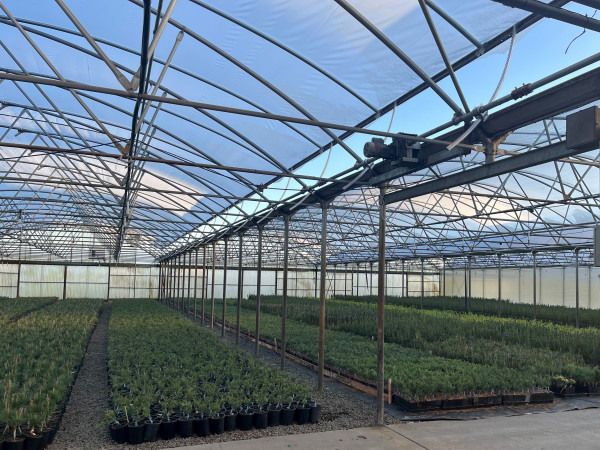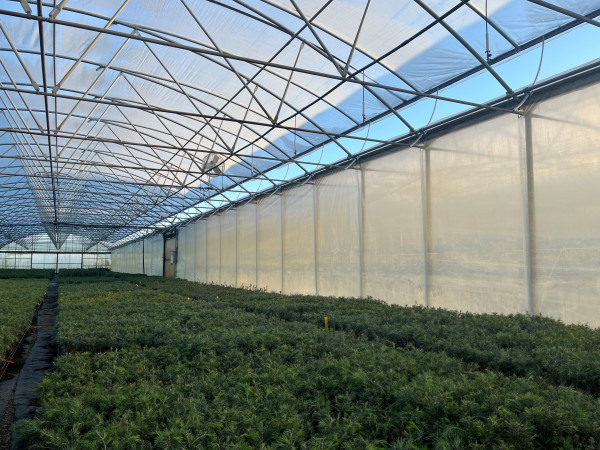Many growers are dealing with widely (some might say wildly) changing temperatures this season, which is a challenge for production timing and finishing of crops. Roll-up side- and- end walls, shade cloth, energy curtains, and pad-and-fan systems all help growers manipulate the environment within the greenhouse. Airflow through the production area is essential for reducing humidity and plant disease. With electricity costs at a premium, growers can lower usage by harnessing the natural physics of air movement to keep a hot greenhouse cool.
One of the most efficient ways to maintain consistent temperatures is with roof vents, explains Stuppy Greenhouse. "They offer several advantages over pad-and-fan cooling systems, chiefly less use of electricity and more consistent cooling throughout the greenhouse, especially in the center. Crops can be hardened off directly on the bench — a significant labor savings."

Keith Coleman, co-owner of KCK Farms, LLC, in Dayton, Oregon, says he likes roof vents so much he continues to retrofit them onto his Rainbow® gutter-connected greenhouses. Coleman co-owns the business with his brother, Kevin Coleman, and they raise a variety of crops, ranging from fruit tree rootstocks, cut flowers, and bare root trees and shrubs for the ornamental market. He has added roof vents to most of his propagation houses and plans to do more this year.
“I think it’s a great add-on to a house for ventilating,” he says. “The roof vent goes the entire length of the house, so you get cooling throughout the entire structure. It’s better than just having curtains on the ends.”
The savings are real
Roof vents offer significant electricity cost savings over pad-and-fan systems. According to John Bartok Jr., Emeritus Extension Professor, and Agricultural Engineer at the University of Connecticut, fan ventilation uses between 0.5 to 1-kilowatt hour per square foot per year, while roof vents require just a small, 1/20 horsepower gear motor to open and close the vents a few times per day.
Roof vents work on the principle that hot air rises and cool air sinks. The system works best when sidewalls can be rolled up and down. Hot air rises and exits through the roof, pulling cooler air in from the sides of the greenhouse below. A slight breeze of just two or three miles per hour can aid this process and provide at least 80% of the ventilation needed. If sidewalls are closed, cooler air is pulled in through the bottom of the roof vent and sinks to lower areas of the house. Horizontal fans should be shut off to avoid mixing the hot and cold air layers.

Roof vents can be operated manually, but a thermostat controls Coleman’s. “I set the temperatures I want for opening and closing the vents, and sensors trigger them to operate,” he says. “It really helps us to grow better plants by keeping the humidity down, keeping the heat down, and keeping temperatures consistent throughout the entire greenhouse. I can’t really put a figure on the return on investment, but it’s peace of mind more than anything. And we’re reducing our power consumption.”
There are a few factors to consider before installing roof vents. Once they are in place, it is difficult to cover the house with poly. Shade cloth needs to be porous to allow air to circulate vertically, and the vent mechanisms require routine maintenance.
Coleman says he has had no issues with leaks or snow load since he has installed roof vents. “In a perfect world, roof vents are the way to go on most structures because you can consistently get the heat out of the top of the greenhouse.”
Coleman’s Rainbow gutter-connected greenhouses are slightly wider than the standard; his company started working with Stuppy Greenhouse more than 30 years ago. He says Stuppy engineers custom designed the roof vents to meet the dimensions of his 35-foot (as opposed to 30-foot)-wide houses. “They did a great job, and everything fits, and we’re really happy with it,” he says. “We’ve continued to work with Stuppy through the years because they make a really nice structure with a finished look. You can tell they care about quality.”
For more information:
Stuppy Greenhouse Manufacturing
www.stuppy.com
